Dosidicus
Dosidicus gigas
Jumbo squid
Richard E. Young and Michael VecchioneIntroduction
D. gigas is the largest of the ommastrephids reaching a weight of approximately 50kg and a mantle length of 1.2 m (Nigmatullin et al., 2001). It is known only from the Eastern Pacific.
Watch a video of D. gigas off California
Brief diagnosis:
An ommastrephid ...
- with elongate, whip-like arm tips in subadults; arms with 100-200 pairs of suckers.
Characteristics
- Arms
- Arm tips attenuate, becoming whip-like in subadults; arms I with 60 to >200 pairs of suckers. Other members of the subfamily have less than 35 pairs (Wormuth, 1976).
- Trabeculae of dorsal protective membranes on arms project well beyond membrane.
- Ventral protective membrane of arms III narrow, not greater than arm width.
- Hecto - Medial pores variable, perhaps depending on stage of hectocotylus development; pores may be last structures to develop (Wormuth, 1975).
 Click on an image to view larger version & data in a new window
Click on an image to view larger version & data in a new window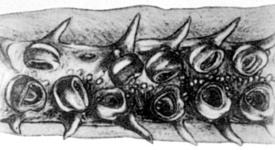
Figure. Oral view of the base of arm II of D. gigas. Drawing from Pfeffer (1912).
- Arm tips attenuate, becoming whip-like in subadults; arms I with 60 to >200 pairs of suckers. Other members of the subfamily have less than 35 pairs (Wormuth, 1976).
- Tentacles
- Largest club suckers with small pointed teeth and one large pointed tooth in each quadrant.
- Club with 49-58 rows of suckers. Other members of the subfamily have 40 or fewer rows (Wormuth, 1976).
- Carpal locking apparatus with smooth-ringed locking suckers extending further proximally on tentacle than normal toothed suckers (Wormuth, 1976).
- Head
- Beaks: Descriptions can be found here: Lower beak; upper beak.
- Funnel groove with foveola and side pockets.
- Beaks: Descriptions can be found here: Lower beak; upper beak.
- Funnel
- Mantle component of the locking-apparatus with anterior bifurcation. A full description of the funnel/mantle locking apparatus can be seen here.
- Mantle component of the locking-apparatus with anterior bifurcation. A full description of the funnel/mantle locking apparatus can be seen here.
- Photophores
- Small subcutaneous photophores on ventral surfaces of mantle, head and arms III-IV (Wormuth, 1976).
- Single ocular and two intestinal photophores present in juveniles between 12-15 and 100-140 mm ML (Nigmatullin et al., 2001).
Life History
Hatchlings are 1.1 mm ML and lack photophores. Life span is about one year based on the assumption that statolith increments are daily and this is supported by cohort analysis using length-frequency distributions although the largest specimens may exceed a year. A 770 mm ML male had 352 increments and a 860 mm ML female had 338 increments. Paralarvae and juveniles grow 5-8% in ML per day reaching 100-110 mm ML in 45-55 days. (Nigmatullin et al., 2001). Off Peru, Argüelles et al (2001), using statolith increments found the maximum age found was 354 days for a 855 mm ML male and 344 days for a 965 mm female.
Nigmatullin et al. (2001) suggest that the population consists of three groups based on size: 1) Small - males become mature at 130-260 mm ML and females at 140-340 mm ML; 2) Medium - males become mature at 240-420 mm ML and females at 280-600 mm ML; 3) Large - males become mature at 400-500 mm ML and females between 550-600 and 1000-1200 mm ML. The Small group is found predominately in and near the equatorial area, the Medium group is found throughout the whole range except at extremely high latitudes, and the Large group is found the the northern and southern peripheral regions. Off Peru, Argüelles et al (2001) found two size groups, small (<490 mm ML) and large (>520 mm ML).
Behavior
The very attenuate arm tips of D. gigas bearing numberous small suckers suggests that this squid has somewhat different feeding methods than found in most ommastrephids. MBARI in situ ROV videos have captured two types of feeding.
Type 1:
This is the typical type of feeding in which prey are initially captured by the tentacles. Squid images (below) from single video frames are placed side-by-side (except number 6 which is a transparent overlay) to show the behavior.
1 (see figure below). D. gigas approaches the prey (Gonatopsis borealis).
2. Tentacles extended with clubs apparently locked together at the carpal locking apparatus and the terminal pads. The manus of each club contacts the prey.
3. The force of the tentacle extension drives the captured prey further away.
4. D. gigas appears to be securing it's hold on the prey.
5. Tentacles retract and curl inward to bring the prey into contact with the basal arm suckers.
6. D. gigas darts away (transparent overlay) with the tentacles still curled toward the arm bases and with arms extended.

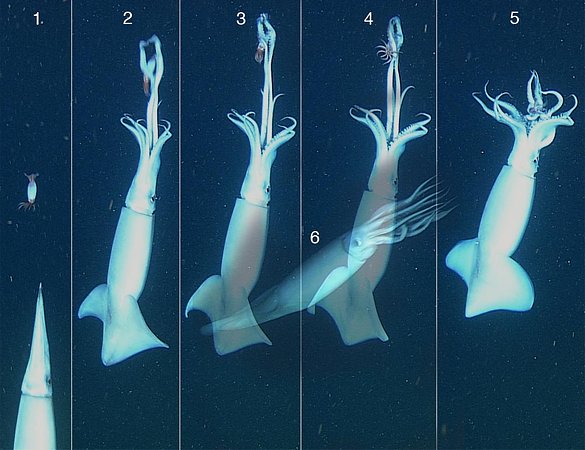
Figure. Six images of D. gigas taken from a single video sequence showing tentacle feeding. The in situ images taken from an MBARI ROV at 847m. Photographs © MBARI.
Type 2:
We call this type "cage feeding." This method involves using primarily the arms. As in the figure for Type 1, squid images from single video frames are placed side-by-side to show the behavior
1 (see figure below). The squid begins to form the cage with the arms, tentacles and arm suckers all involved. The anttenuate arm tips, however, are curled aborally and play role in this feeding method. The arms are somewhat spread and form the ribs of the cage. The arm suckers are flared laterally on each arm which form the mesh of the cage. [This is most easily seen in image 5 of a second individual squid in which the camera has an aboral view of arm II (arrow) that shows the extreme lateral spread of the suckers.] The squid has moved forward to engulf a myctophid fish through the open, anterior end of the cage (see grey arrow). Note that the tentacle club (below the arrow) is also involved in forming the cage.
2. The cage begins to close with the fish still well inside (grey arrow). The ends of the arms, posterior to the slender tips begin to close the cage entrance.
3. The cage is closed with the fish trapped inside.
4. The cage collapses as the arms are straightened and brought together. Then a proximal region of left arms 1 bows outward as the arm apparently pushes the fish toward the squid's mouth.
5. This is an insert that serves to clarify figure 1.

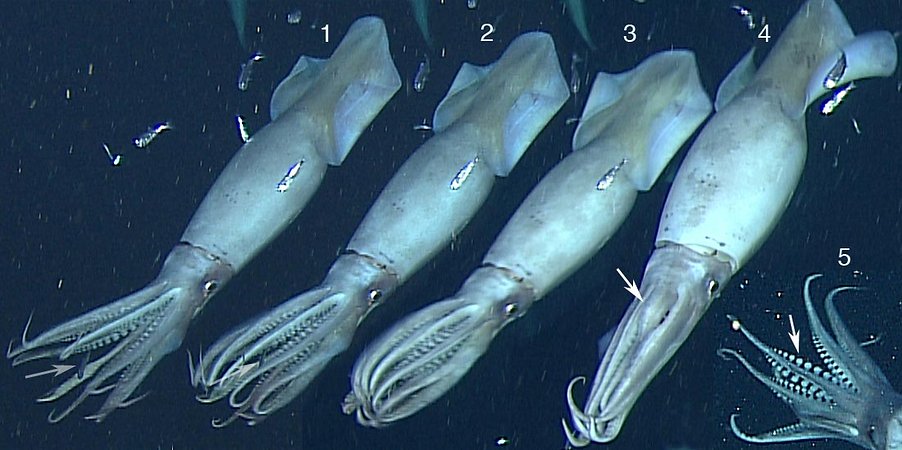
Figure. Four images of D. gigas taken from a single video sequence showing cage feeding plus an insert of a second squid. In situ images taken from an MBARI ROV at 500m. Photographs © 2013 MBARI.
Type 3:
Type 3 involves the use of the attenuate arm tips of D. gigas to capture euphausiids (B. H. Robison, presonal communication). No videos are available at present.
Distribution
Eastern Pacific Ocean from 26°S to mid-Baja, California with occasional north and south expansions. Presently from about 60°N to 47°S.
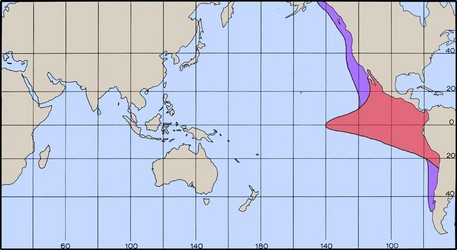
Figure. Distribution map of D. gigas. Red - Common historical distribution. Purple - Recent expansion. Red , purple is the total present distribution. Expansion to the south appears to have been more frequent in the past than to the north. Historical data mostly from Wormuth (1976).
References
J. Argüelles, J., P.G. Rodhouse, P. Villegas, G. Castillo. 2001. Age, growth and population structure of the jumbo flying squid Dosidicus gigas in Peruvian waters. Fisheries Research 54: 51-61.
Nigmatullin, Ch.M. , K.N. Nesis and A.I. Arkhipkin. 2001. A review of the biology of the jumbo squid Dosidicus gigas (Cephalopoda: Ommastrephidae). Fisheries Research 54: 9-19.
Pfeffer, G. 1912. Die Cephalopoden der Plankton-Expedition. Ergebniss der Plankton-Expedition der Humboldt-Stiftung. 2: 1-815.
Title Illustrations

| Location | Monterey Bay Canyon, Northeast Pacific at 36.7°N, 122.2°W; 503 m depth |
|---|---|
| Comments | Image courtesy of the Monterey Bay Aquarium Research Institute (MBARI). You must obtain permission from MBARI to use this photo; please contact pressroom@mbari.org for further information |
| Acknowledgements | Susan Von Thun, photo editing, MBARI |
| Specimen Condition | Live Specimen |
| View | Side |
| Copyright | © 2011 MBARI |
About This Page

University of Hawaii, Honolulu, HI, USA

National Museum of Natural History, Washington, D. C. , USA
Page copyright © 2017 and
 Page: Tree of Life
Dosidicus . Dosidicus gigas . Jumbo squid.
Authored by
Richard E. Young and Michael Vecchione.
The TEXT of this page is licensed under the
Creative Commons Attribution-NonCommercial License - Version 3.0. Note that images and other media
featured on this page are each governed by their own license, and they may or may not be available
for reuse. Click on an image or a media link to access the media data window, which provides the
relevant licensing information. For the general terms and conditions of ToL material reuse and
redistribution, please see the Tree of Life Copyright
Policies.
Page: Tree of Life
Dosidicus . Dosidicus gigas . Jumbo squid.
Authored by
Richard E. Young and Michael Vecchione.
The TEXT of this page is licensed under the
Creative Commons Attribution-NonCommercial License - Version 3.0. Note that images and other media
featured on this page are each governed by their own license, and they may or may not be available
for reuse. Click on an image or a media link to access the media data window, which provides the
relevant licensing information. For the general terms and conditions of ToL material reuse and
redistribution, please see the Tree of Life Copyright
Policies.
- First online 29 November 2009
- Content changed 08 January 2013
Citing this page:
Young, Richard E. and Michael Vecchione. 2013. Dosidicus . Dosidicus gigas . Jumbo squid. Version 08 January 2013 (under construction). http://tolweb.org/Dosidicus_gigas/19945/2013.01.08 in The Tree of Life Web Project, http://tolweb.org/





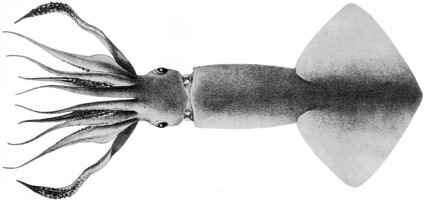


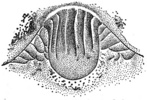
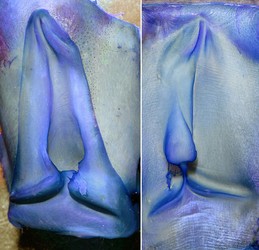



 Go to quick links
Go to quick search
Go to navigation for this section of the ToL site
Go to detailed links for the ToL site
Go to quick links
Go to quick search
Go to navigation for this section of the ToL site
Go to detailed links for the ToL site